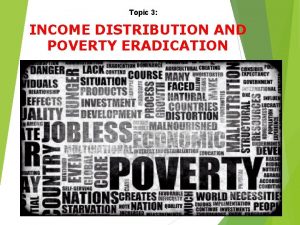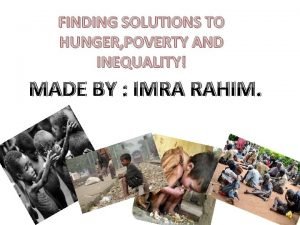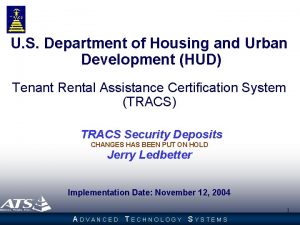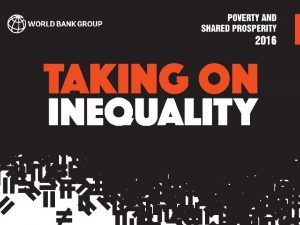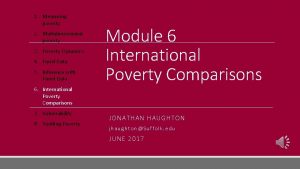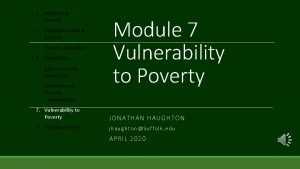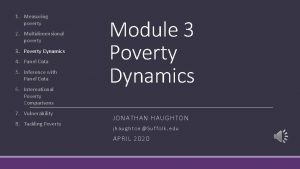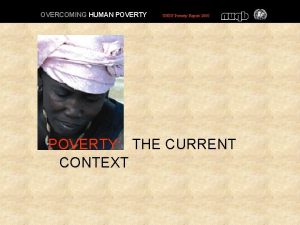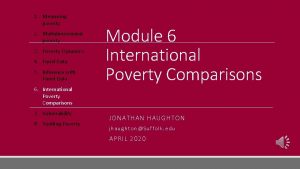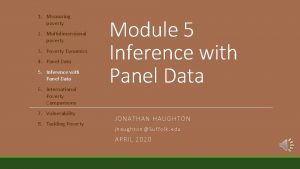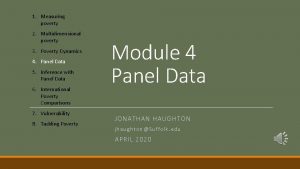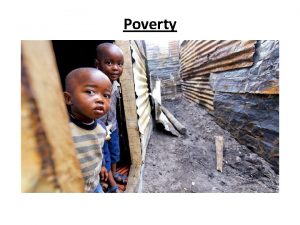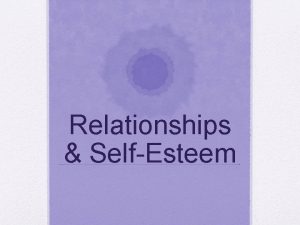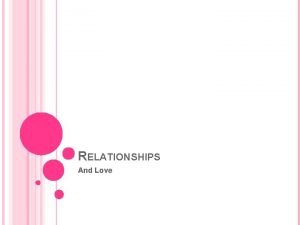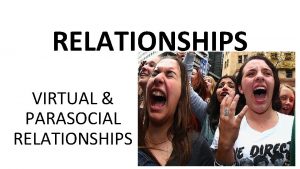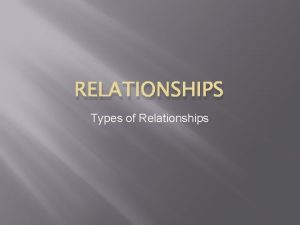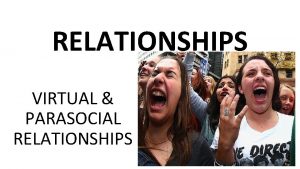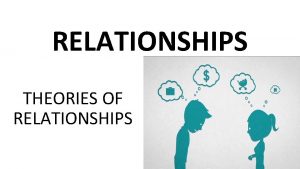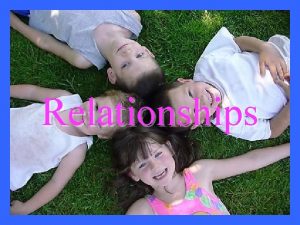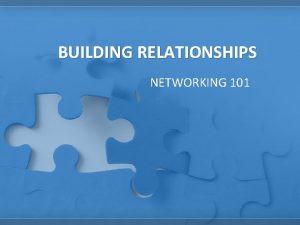How Relationships and Poverty Affect the 21 st




















- Slides: 20

How Relationships and Poverty Affect the 21 st Century Learning Environment Locate a resilient kid and you will also find a caring adult – or several – who has guided him. --Invincible Kids, U. S. News World Report

Creating Lasting Relationships Seek first to understand • Keeping promises • Kindness, courtesies • Clarifying expectations • Apologies • Open to feedback

Creating Relationships Withdrawals • • Seek first to be understood Breaking promises Unkindness, discourtesies Violating expectations Disloyalty, duplicity Pride, conceit, arrogance Rejecting feedback Covey(1989) uses the notion of an emotional bank account to convey the crucial aspects of relationships. He indicates that in all relationships one makes deposits to and withdrawals from the other individual in that relationship.

What Do I Mean By Relationships? • Should students become my personal friends? • Should I go out with them? • Successful relationships occur when emotional deposits are made to the students and emotional withdrawals are avoided, and students are respected. • Are there boundaries to the relationship? • By understanding deposits that are valued by students from poverty, relationships grow stronger.

DEPOSITS MADE TO INDIVIDUALS IN POVERTY • Appreciation for humor and entertainment provided by the individual • Acceptance of what the individual cannot say about a person or situation. • Respect for the demands and priorities of relationships • Using the adult voice • Assisting with goal setting • Identifying options related to available resources • Understanding the importance of personal freedom, speech, and individual personality

WITHDRAWALS MADE FROM INDIVIDUALS IN POVERTY • Put downs or sarcasm about the humor or the individual. • Insistence and demands for full explanation about a person or situation. • Insistence on the middle-class view of relationships. • Using the parent voice. • Telling the individual his/her goals. • Making judgments on the value and availability of resources. • Assigning pejorative character traits to the individual.

Building Relationships • How does an organization or school create – and build – relationships? 1. Through support systems 2. Through caring about students 3. By promoting student achievement 4. By being role models 5. By insisting upon successful behaviors for school

Relationships • What does this information mean in the school setting? 1. For students and adults from poverty, the primary motivation for their success will be in their relationships. 2. Is your school setting presently affords few opportunities for building relationships, find ways to establish natural connections that will enable this vital resource to take root and grow?

Some Key Points To Remember • • Poverty is relative. If everyone around you has similar circumstances, the notion of poverty and wealth is vague. Poverty or wealth only exists in relationships to known quantities or expectations. Poverty occurs in all races and in all countries. The notion of middle class as a large segment of society is a phenomenon of this century. The percentage of the population that is poor is subject to definition and circumstance. Generational poverty and situational poverty are different. Generational poverty is defined as being in poverty for two generations or lower. Situational poverty is a shorter time and is caused by circumstance. (i. e. , death, illness, divorce. etc. ) An individual brings with him/her the hidden rules of the class in which he/she was raised. Even though the income of the individual may rise significantly, many of the patterns of thought, social interaction, cognitive strategies, etc. , remain with the individual. Schools and business operate from middle-class norms and use the hidden rules of middle class. These norms and hidden rules are not directly taught in schools or in businesses. For our students to be successful, we must understand their hidden rules and teach them the rules that will make them successful at school or work. We can neither excuse students nor scold them for not knowing; as educators, we must teach them and provide support, insistence, and expectations.

Key Points To Remember • • To move from poverty to middle class or middle class to wealth, an individual must give up relationships for achievement (at least for some period of time). Two things that help one move out of poverty are education and relationships. Four reasons one leaves poverty are: It’s too painful to stay, a vision or goal, a key relationship, or a special talent or skill. Poverty is caused by interrelated factors: parental employment status and earnings, family structure, and parental education.

Definitions and Resources • To better understand students and adults in poverty, a working definition of poverty is “the extent to which an individual does without resources. These resources are the following. Financial: Having the money to purchase goods and services. Emotional: Being able to choose and control emotional responses, particularly to negative situations, without engaging in self-destructive behavior. This is an internal resource and shows itself through stamina, perseverance, and choices. Mental: Having the mental abilities and acquired skills ( reading, writing, computing) to deal with daily life. Spiritual: Believing in divine purpose and guidance. Physical: Having physical health and mobility. Support Systems: Having friends, family, and backup resources available to access in times of need. These are external resources. Relationships/Role models: Having frequent access to adults) who are appropriate, who are nurturing to the child, and who do not engage in selfdestructive behavior Knowledge of hidden rules: Knowing the unspoken cues and habits of a group

Support Systems • Support systems are the friends, family, and backup resources that can be accessed in times of need.

Support Systems tend to fall into seven general categories. 1. 2. 3. Coping Strategies — the ways in which one copes with daily living: the disappointments, the tragedies, the triumphs. Coping strategies are ways to think about things, attitudes, self talk, strategies for resolving conflicts, problem solving techniques, and the avoidance of needless conflicts. Coping strategies are also ways of approaching tasks, setting priorities, and determining what one can live with and what one can live without. Options During Problem-Solving — options are all the ways to solve a problem. Even very capable adults often talk over a problem with another adult just in order to see other options they haven’t considered. Information and Know-How — this is the key aspect of a support system. When a child has homework, who in the support system knows enough math to help the child? Who knows the research process? Who knows the ropes for going to college or getting a new car loan? Who knows how to talk to the insurance agent so the situation can be clarified? Who knows how to negotiate difficult situations with a teacher and come to a resolution? Who understands the court system, the school system?

Support Systems 4. 5. 6. 7. Temporary Relief from Emotional, Mental, Financial, and/or Time Constraints– when you are upset, who provides relief for you? When you aren’t sure how you will get everything finished, who helps you? Who takes your children when you are desperate for a break? These people are all part of a support system. Connections to Other People and Resources – when you don’t have the information and know-how, who are the people you turn to for assistance? Those people are your connections. Connections to people and resources are integral part of a healthy support system. Positive Self-Talk —everyone has a little voice inside his/her head that talks to him/her all the time. This little voice gives encouraging messages. These encouraging messages help one finish tasks, complete projects, and get through difficult situations. If an individual does not listen to this encouraging little voice, the success rate is much lower. Procedural Self-Talk – Procedural self-talk is the voice that talks an individual through a task. It is key to success. Many individuals in poverty have a very limited support system-and particularly missing is procedural self-talk. Many tasks are never finished. In numerous dealings with students, teachers and other school officials find that self-talk is simply not available to the student.

Support Systems Schools Use • • • School wide homework support: Supplemental school wide reading programs. Keeping students with the same teacher(s) for two or more years or having a school within a school. Teaching coping strategies School wide scheduling-puts students in subgroups by skill for reading and math Parent training and contact through video The direct-teaching of classroom survival skills. Requiring daily goal-setting and procedural self talk. Team interventions

Generational Poverty Generational poverty is defined as having been in poverty for at least two generations; however the patterns begin to surface much sooner than two generations if the family lives with others who are from generational poverty. • Generational poverty has its own culture, hidden rules, and belief systems. • Often the attitude in generational poverty is that society owes one a living.

Generational Poverty Characteristics of Generational Poverty • • • Background “noise”: Almost always the TV is on, no matter what the circumstance. Conversation is participatory, often with more than one person talking at a time. Importance of personality: Individual personality is what one brings to the setting -because money is not brought. The ability to entertain, tell stories, and have a sense of humor is highly valued. Significance of entertainment: When one can merely survive, then the respite from the survival is important. In fact, entertainment brings respite. Importance of relationships: One only has people upon whom to rely, and those relationships are important to survival. One often has favorites. Matriarchal structure: The mother has the most powerful position in the society if she functions as a caretaker. Oral language: Casual register is used for everything. Survival orientation: Discussions of academic topics is generally not prized. There is little room for the abstract. Discussion center around people and relationships. A job is about making enough money to survive. A job is not about a career.

Generational Poverty • • Identity tied to lover/fighter role for men: The key issue for males is to be a “man. ” The rules are rigid and a man is expected to work hard physically—and be a lover and a fighter. Identity tied to rescuer/martyr role for women: A “good” woman is expected to take care of and rescue her man and her children as needed. Importance of non-verbal/kinesthetic communication: Touch is used to communicate, as are space and non verbal emotional information. Ownership of people: People are possessions. There is a great deal of fear and comment about leaving the culture and “getting above your raisings. ” Negative orientation: Failure at anything is the source of stories and numerous belittling comments. Discipline: Punishment is about penance and forgiveness, not change. Belief in fate: Destiny and fate are the major tenets of the belief system. Choice is seldom considered. Polarized thinking: Options are hardly ever examined. Everything is polarized: it is one way or the other. These kind of statements are common: “I quit and “I can’t do it. ”

Generational Poverty • • • Mating dance: The mating dance is about using the body in a sexual way and verbally and sub verbally complimenting body parts. If you have few financial resources, the way you sexually attract someone is with your body. Time: Time occurs only in the present. The future does not exist except as a word. Time is flexible and not measured. Time is often assigned on the basis of the emotional significance and not the actual measured time. Sense of humor: A sense of humor is highly valued, as entertainment is one of the key aspects of poverty. Humor is almost always about people either situations that people encounter or things people do to other people. Lack of order/organization: Many of the homes/apartments of people in poverty are unkempt and cluttered. Devices for organization (files, planners) don’t exist. Lives in the moment—does not consider future ramifications: Being proactive, setting goals, and planning ahead are not a part of generational poverty. Most of what occurs is reactive and in the moment. Future implications of present actions are seldom considered.

Hidden Rules Among Classes What are hidden rule? • • Hidden rules are the unspoken cues and habits of a group. The bottom line in generational poverty is entertainment and relationships. In middle class, the criteria against which most decisions are made relate to work and achievement. In wealth, it is the ramifications of the financial, social, and political connections that have the weight. Being able physically to fight or have someone who is willing to fight for you is important to survival in poverty. In middle class, being able to use words as tools to negotiate conflict is crucial. Many times the fists are used in poverty because the words are neither available nor respected. Rules
 Relative and absolute poverty
Relative and absolute poverty Relative and absolute poverty
Relative and absolute poverty Poverty and juvenile delinquency
Poverty and juvenile delinquency Sandra cisneros bio
Sandra cisneros bio St john chrysostom on wealth and poverty pdf
St john chrysostom on wealth and poverty pdf Poverty and hunger solutions
Poverty and hunger solutions Symbolic interactionist perspective on poverty
Symbolic interactionist perspective on poverty Hudco full form
Hudco full form Inequality and poverty
Inequality and poverty Greed and poverty
Greed and poverty Hình ảnh bộ gõ cơ thể búng tay
Hình ảnh bộ gõ cơ thể búng tay Ng-html
Ng-html Bổ thể
Bổ thể Tỉ lệ cơ thể trẻ em
Tỉ lệ cơ thể trẻ em Gấu đi như thế nào
Gấu đi như thế nào Chụp phim tư thế worms-breton
Chụp phim tư thế worms-breton Bài hát chúa yêu trần thế alleluia
Bài hát chúa yêu trần thế alleluia Môn thể thao bắt đầu bằng từ chạy
Môn thể thao bắt đầu bằng từ chạy Thế nào là hệ số cao nhất
Thế nào là hệ số cao nhất Các châu lục và đại dương trên thế giới
Các châu lục và đại dương trên thế giới Công của trọng lực
Công của trọng lực
